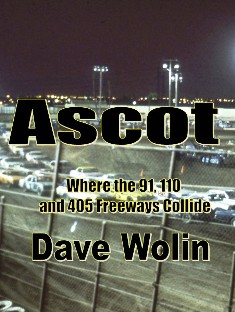Ascot

The
story of the iconic dirt track that defined Southern California racing;
from it's beginnings in 1903 as a horse track, then as a one mile dirt
track in L.A., then as New Ascot Raceway in East L.A. which became
Legion Ascot and finally Southern Ascot in Southgate. Los Angeles
Speedway was built in 1957 on the site of a former landfill just south
of Gardena. The promoter got into financial difficulties and it became
New Ascot Stadium and eventually just Ascot. Read the book to see why
it closed in 1990. 399 Pages - 8 1/2 x 11 - B&W. Autographed by the
author; comes with a DVD of all the photos and, newspaper /
magazine articles in the book plus an assortment of videos.
Read the review from LACar.com (edited for brevity) -This is a feisty, tough little (is 399 pages with what must be a thousand photos really “little”?) MOFO (of a book) that triggers memories long dulled by watching racing live, and in person TV racing from four of five camera angles and then again from the blimp or fast-flying drone and over and over in replay. Ascot was a blink and you’ll miss it, in your face, wall to wall. It was a “shut the (heck) up and race” joint that some seem to master, but that very few had a real wrap-around view of. That track seemed to thrive on being mythical, moody, a place where almost everything went for even the best of them and winning was a cause for great celebration.
It
has always been something of and anomaly that no book (until now) had
been written about the place where some of the greatest dirt short track
racing ever seen had thrilled generations of Angelenos over it’s short,
33-year life.If you were lucky enough to have been there, I’m sure
noise and smells are hard to forget. Chevy V-8s screaming out while
being tortured by competitors who had “tipped the can” and doctored the
nasty, eye-watering methanol fuel with “liquid dynamite” (nitro-methane)
to get a few horsepower over another racer and who’s motor oil spit out
on to red-hot open exhaust.… In case you didn’t notice, this is a book
that every LA motorsports fan of a certain age has been asking for for a
long time now … a scrapbook of photos and news clips that recount (and
remind in a lot of cases) of the glory that was Ascot, where the
ambiance was not about the place, but exclusively about the sort racing
that went on there for thirty-three years.
Although
some raved about the burgers at the infield snack bar, they really were
only moderately passable because, if you were in the infield, there was
no way to get out while the races where being run.
There
was a graveyard (honest) dead nuts (that’s an arcane racing term that
means exactly, precisely) named Roosevelt Memorial Park just across
Vermont Avenue from the front gates, rumors were passed that the track
was the beneficiary of any excess dirt that was generated by that
business. So far as this writer knows there never was any confirmation
of that.
And then
there’s the weather (not for nothing do they call the area “The South
Bay”) being relatively close to the Pacific Ocean meant some cool, damp
Summer nights and a well-hydrated track, that rarely if ever dusted up.
In fact it also often called for warm clothes on almost any night after
8, a fact that became more pronounced as the racing calendar rolled on
towards fall, all of which was doubtless good for sweat shirt sales.
Bench
seats, no elevators, and basically cultist sections of fans would rule
their own territories almost as if it was somehow a birthright.
Marijuana possession and smoking was a criminal offense during the time
of this track, but that never seemed to hinder the sickly-sweet odor of
burning “weed” from being an important factor (either way) in seat
location at Ascot.Like all dirt tracks, there was a cadre lurking down
low in turn one, die-hard patriots who wouldn’t be happy watching from
the owner’s box (as if Ascot would ever have had one). They wore
eye-protection and face masks, loved to be pelted by fast-flying chunks
of clay, and did not consider a beer to be a proper drink without (at
least) a quarter inch of the track swirling around in the bottom of
their beer cup.
And
racing... oh the racing! Those who were to do battle and those that
flocked to watch the battling on Ascot’s dirt will all tell you all
about the epic battles that they sat witness to on the “short”
half-mile. Measured on the outermost part of the racing surface (the
crash fence) it clocked in as being on the skinny side of an official
two thousand, six hundred, and forty feet long. But every foot, no
matter what the tape made it, was jam-packed with real racing action at
that joint.The growling motorcycles, the howling sprint cars, the
screaming midgets, the high-flying off-road buggies and three-wheelers,
the blunt force trauma of the demolition derby cars, the shouting
parents of the bike-x kids, even the occasional “over-served” fan who
decided to see what kind of a lap they could cut on foot, all conspired
to make a very satisfying show at Ascot. It always managed to be that
kind of place - the one where (the you know whats) COL-LIDE.Wolin’s use
of photos - and contemporary news articles - pays off in the best way
possible for the Ascot legend. There’s a ton of truth in this one.
Thanks for all the memories Mister Wolin!